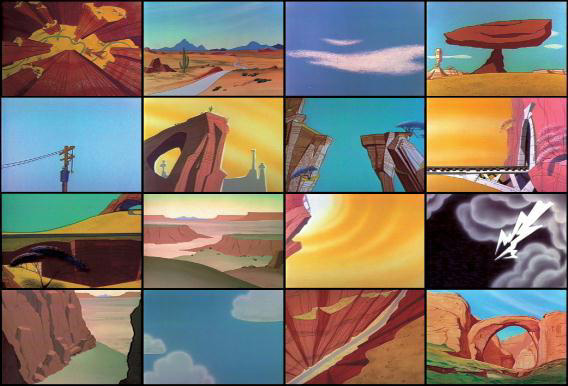
“Erasure is never merely a matter of making things disappear: there is always some detritus strewn about in the aftermath, some bruising to the surface from which word or image has been removed, some reminder of the violence done to make the world look new again”.
— Brian Dillon
Some more loose notes on (audio)visual erasure (see also previous post), in the context of a little program we’re doing in a few weeks. One part of the program (proposed title: “Without a Trace. Erasing Inscription, Inscripting Erasure”) will be a performance by Pierre Hébert, titled ‘only the hand‘, starting from Meister Eckhardt’s famous quote “Only the hand that erases can write the true thing” (btw: Godard said smth similar – “seule la main qui efface peut écrire” ” to express his thoughts about the incapacity of art and film to discuss the Holocaust). Hébert explores the relationship of this quote with his own workflow, doing live improvised animation, alternately drawing and erasing. Hébert writes: “the animated movement cannot appear without the action of erasing. It also interest me because it relates the question of truth to very physical actions that put the body into motion, that is writing and erasing, and not just to the act of “saying the truth” although speech is always present as a ground. It seemed to me that the impossibility to attribute this sentence to any single author did authorized me to give it a meaning that suited my needs without necessarily discarding all of the possible historical interpretation of it”.
This is an extract of a performance he did in Beyrouth (French version)
This performance somewhat relates to Christian Capurro‘s ‘A.M.P.E.d.S. (Another Misspent Portrait of Etienne de Silhouette)’ project (which will be part of the forthcoming edition of the ARTEFACT festival, titled ‘Behind the Image: The Image Behind’), which involves a mass-collaborative erasure of a 246 page Vogue Hommes magazine. “The magazine has been diminished, emptied of its original, primarily pictorial content and re-inscribed, palimpsest-like, by other energies and with other values. In the process, and while maintaining the basic integrity of its original form – an impersonal, mass produced, and ephemeral product of popular culture – this out of date object with little intrinsic worth was transformed: invested with a significant amount of time (267 hours, 49 minutes, 5 seconds…), of attention, of labour, and propositionally endowed with considerable value (AUD$11,349.18…). The artefact that has resulted from this drawn-out, yet economical mass undertaking could be thought of as a social and/or artistic document of a certain disproportionate investment and disproportionate attention: one that hopefully embodies some of the paradoxical impulses evident within the contemporary politic of images, toward both negation and proliferation”.
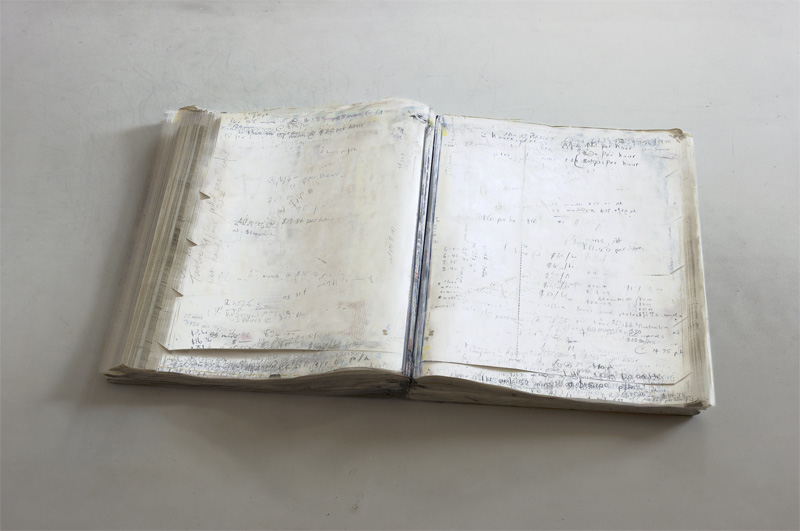
In some ways, writing or painting can already be considered as acts of erasure (see Brian Dillon, ‘the revelation of erasure‘) (just as animation and cinema can be seen as acts of progressive erasure: one image superseding the previous one to create an impression of movement). Every painting, said Picasso, is a sum of destructions: the artist builds and demolishes in the same instant. Which is perhaps what Jasper Johns had in mind when he said of Robert Rauschenberg’s ‘Erased de Kooning Drawing’ (1953) that it embodied an “additive subtraction”: after a month’s sporadic destruction – using about 40 rubber erasers to literally rub-out a drawing that he had persuaded de Kooning to give him specifically for that purpose – what is left is a surface startlingly alive, active, palimpsestic. Rauschenberg himself stressed that the main aim of this work was to find out “whether a drawing could be made out of erasing” – the eraser was used as a drawing tool, working over the top of the old drawing, to create a new work. Soundwise, George Maciunas did a similar thing with ‘Homage to Richard maxfield’ (1962) – erasing a master tape of Maxfield while rewinding. Any form of erasure, however violently destructive, can be seen as constructive in some way – any erasure carries within it the potential for renewal or reinvention, made possible by the knowledge gained through the erasure of the old. For Willem Oorebeek, whose ‘Black Out’ series consists of pictures which are are overprinted with a layer of black ink – so the image is only visible when the light on the black surface is seen from a particular angle – erasure can rescue the image “from a one-dimensional view.” “It subjects it to a momentary form of blankness”, wrote Wouter Davidts, allowing it to resurface again, as an afterimage”. Erasure is a “process which makes the new visible to itself as it redefines what is visible in the old”, wrote Richard Galpin in his essay ‘Erasure in Art: Destruction, Deconstruction, and Palimpsest‘, extending on Derrida’s notion of ‘sous rature’ (under erasure). He gives the example of Ad Reinhardt, who reduced painting to a flat black canvas, which he described as “the last painting which anyone can make”. Joseph Kosuth wrote of his work: “Painting itself had to be erased, eclipsed, painted out in order to make art.”
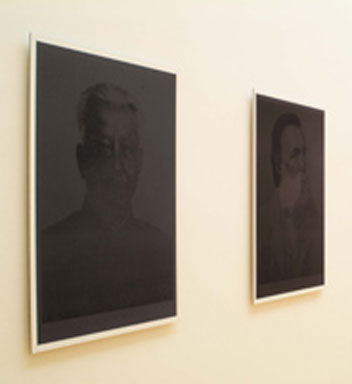
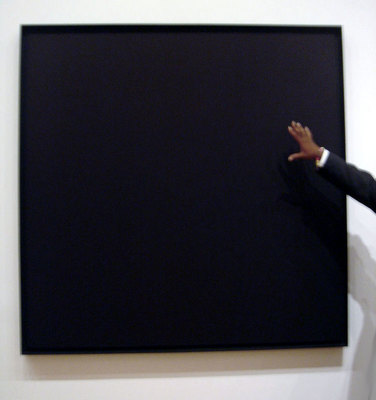
Kosuth himself made some works that use erasure/deletion in a less “absolute” way, being more involved with the erased “sign”. In his installation series ‘Zero and Not’ (1985 – 1986, see figure above) he partially erased texts by Freud, as a sort of ironic affirmation of Freud’s theories. The text is printed on the gallery wall, then struck through with black tape, so that it is erased but still insists, remaining more or less readable. Candice Breitz uses a similar strategy in her ‘Ghost Write Series’ (see below). With Tipp-ex she whitens out full sentences, paragraphs or just seemingly sporadic words from the text of cheap romance novels. In doing so she creates a space of possibility and imagination, inviting the viewers to reconstruct the narrative itself or accidentally creating their own.
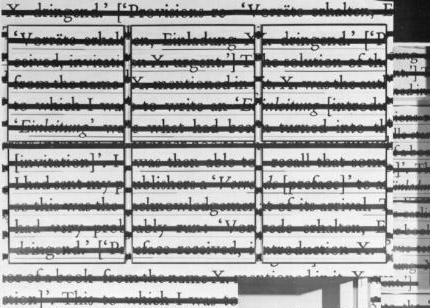

In her ‘Ghost Series’ she again uses Tippex to whiten the bodies of women on ethnographic tourist postcards (see image below). This reminds me of Matt Bryans’ work (see below), for which he snips out black-and-white images from assorted newspapers and, using an eraser, rubs away identifying features to leave only eyes, mouths and shadowy silhouettes – which, in a strange way ressemble the defacings in some found copies of the book ‘Ten Years of Uzbekistan‘ (1934) designed by the Constructivists Alexander Rodchenko and Vavara Stepanova, who were driven to obliterate, with ink and paint, the names and faces of those in that book who had fallen from the favour of and been destroyed by Stalin (documented by Ken Campbell). Gert Jan Kocken also documented some defacings in his work, mainly the remains of Reformation iconoclasm in Holland, England, Germany and Switzerland. Dillon writes: “More than any other image, an erased human face remains horribly eloquent. In fact, a face cannot be made to vanish completely: it stays sufficiently human to horrify by its exact lack of humanity.”
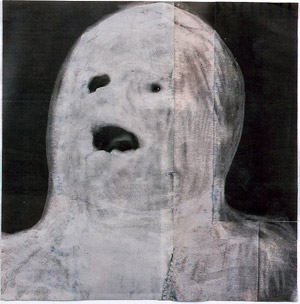
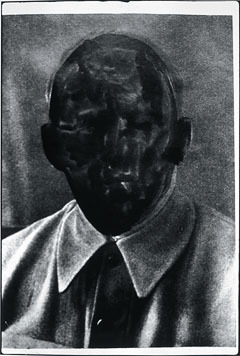
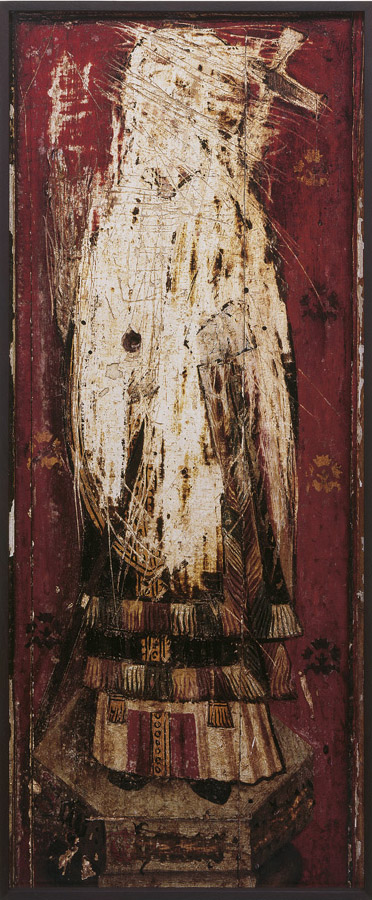
Breitz’ ‘Ghost Series’ also reminds me of Naomi Uman’s amusing 1999 film ‘Removed’, for which she used nail polish remover and household bleach to erase the female figures from an old and forgotten porn film (see still). The wriggling holes in the film become erotic zones, blanks on which a fantasy body is projected, creating a new pornography. Variations of this idea can be found in photography project such as Justin Jorgesen’s ‘Obscene Interiors‘ or John Haddock’s ‘Internet Sex Photos‘, as well as Pierre Bismuth‘s ‘Collage For Men’.

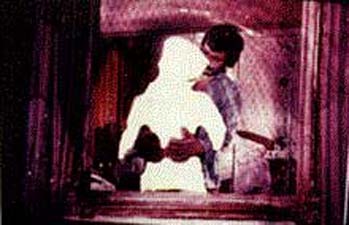
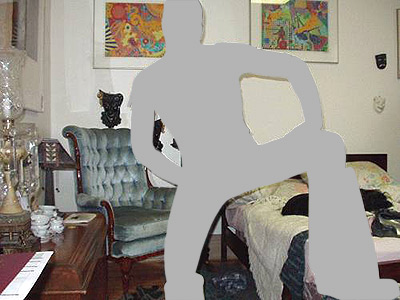

Oliver Laric (see also previous post) did quite the opposite in ‘Touch My Body (Green Screen Version)’, appropriating a video of Mariah Carey and leaving her figure intact but deleting the background images surrounding her body, digitally replacing it with a flat green backdrop, leaving it open for multiple fillings and interpretations (which are flowing on the internet right now).
Erasure can also be understood as camouflage, like in Paul pfeiffer‘s work. In the ongoing photo series ‘Four Horsemen of the Apocalypse’ he edited out all players from images of basketball games, except one. What remains is not an absent but rather an intensified figure. In ‘The Long Count (I Shook Up The World)’ (2000), he altered the footage of a boxing match by digitally erasing the boxers. What’s left on the ring is their ghostly outline, a transparent aura through which one can clearly see the exhilarating reactions in the faces in the crowd of the match. This editing process is very slow and ultimately very manual and requires going frame by frame, even though to a degree the process is somewhat automated through software tools. “It’s like the computer can only think so much and then the human hand and eye really have to do the rest of the refining work”, says Pfeiffer. Filmmaker Martin Arnold can probably acknowledge that. Since 1997 he has been working on a series of works in which he erases actors and actresses from film fragments – like the shower scene from Alfred Hitchcock’s ‘Psycho’. For his video installation ‘Deanimated’ (2002) he literally “de-animated” an old, hour-long Hollywood b-movie (‘The Invisible Ghost’ from 1941) by digitally erasing one character at a time. The increasingly empty scenarios, at times inhabited by actors whose facial expressions have been morphed, “create a ghostly effect that serves to remind us of our own mortality”, reporting the ever presence of abscence. “Essential protagonists of the plot are deleted from the film by ‘digital compositing’, the mouths of couples engaged in a dialogue are morphed closed, orchestral film music surges up to add a dramatic emphasis to non-events. What remains are only traces of events, scanty circumstantial evidence of happenings whose origins are left unexplained: dust whirling up, the sound of gunshots, the horror reflected on the face of a woman recoiling from the void.”


More digital erasure in, for example, Natalie Frigo‘s ‘November 22, 1963’ (2004), an alteration of the Zapruder footage of the John F. Kennedy assassination with the removal of JFK from each frame (as a comment on the modyfied version that was originally mediatised – frames were missing or destroyed, parts of footage cropped). There’s also Jeannette Ehlers ‘Ghost Rider‘ series. In the last video in this series you see a football game without players, leaving a haunting feeling of absence. Coincidentally or not, Tammuz Binshtock had a similar (but at the same time opposite) idea in 2001, resulting in this video:
More examples. This is a segment (titled “invisible borads”) from ‘Yeah Right!’, a film made by Spike Jonze for the Girl Skateboard Team.
And this is a fragment of Martijn Hendriks‘ ongoing video project, based on Hitchcock’s 1963 film ‘The Birds’ from which all birds have been removed (Stephen Fox apparently did smth similar in his video ‘the birds’ (2005), but I never saw that)
Hendriks has recently also started working on This is where we’ll do it, a series of YouTube videos he downloaded, manipulated and uploaded again. He writes: “… the absence of essential elements from widely known images has taken center stage. By digitally erasing exactly those things that matter most, absence, background, memory and doubt are shown to become unexpectedly productive”. This is #6:
Mungo Thomson has used this procédé wonderfully in his ‘The American Desert (for Chuck Jones)’ (2002). He erased the characters from classic Road Runner cartoons, leaving only their barren landscapes. Protagonists and narratives excised, the desert scenes mimic landscape painting. Mostly static, there are only oblique traces of the mayhem that we are used to seeing unfold in these unforgiving wastelands: a train rushes by, we hear rocks tumble down a cliff, a waterfall. As a tribute to animator Chuck Jones, the meditative landscapes also focus attention on the production and iconography of mass media images, how they influence our everyday perceptions, and how they’ve become an indispensable part of Western cultural history. Again, coincidentally or not, a year later Stephen Gray did a similar thing in the video ‘Beep prepared’ (2003).
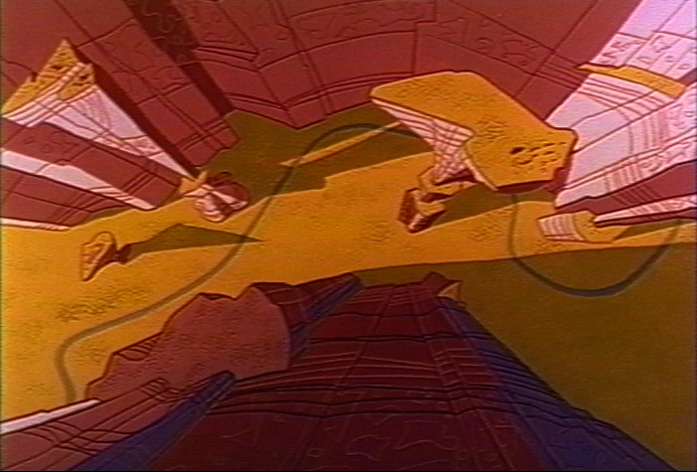
The work shown below is very nice as well. This time it’s not based on any photo- or videographic manipulation, but a modification of Nintendo’s ‘Super Mario’ game. Gone is the main character, who the player had to guide through a labyrinth in the original jump and run game, just like the obstacles, landscapes and opponents that lend the game its narrative structure. Artist Cory Arcangel (see also previous post) had to open the cartridge, on which the game was stored, and replace the Nintendo graphics chip with a one on which he had burned a program he had written himself. As the Source Code is available on the net, the work has continued to perpetuate itself via the Internet, and has been replicated and modified in numerous iterations. The duo JODI has also done an “erased” version of the Quake game, as part of the ‘Untitled Games’ project. In this particular modification (there are 12 for Mac and 13 for PC) all graphical element – monsters, characters and backgrounds – have been eliminated. What remains is the interface components and sound (download it here).

The act of erasing itself is central in the animated films of William Kentridge and Naoyuki Tsuji, which are based on charcoal drawings that are altered and erased in the process. For each film dozens of drawings are made, which undergo continual addition, permutation and erasure, the traces of which are plainly visible. A similar metod is used by Nalini Malani in her first film, ‘Memory; Record/Erase’ (1996), for which she painted directly onto glass, drawing over or erasing the previous images – capturing the ephemeral and unreliable nature of memory and identity.

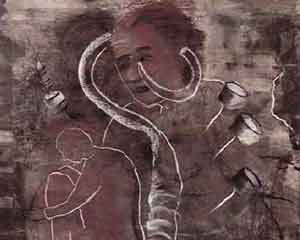
And this is a very nice one too (thanks PP): Denis Savary‘s ‘Le Bourdon’ (2004-2007). Here’s an excerpt:Other examples: Jules Engel’s ‘Accident’ (1973) shows a loop of a dog loping left to right, progressively blurred or erased. Nadia Hironaka has a 16mm installation, entitled ‘Camouflage'(2002), which starts with appropriated images of explosions that are gradually transformed with a hand-fabricated looping mechanism that exposes the film to bleaching vapors. As the film continues the cycle, its emulsion slowly fades and the image is slowly washed away from the filmstrip. In Kirk Tougas’ ‘The Politics of Perception (1973 – see Ghosting the Image program) segments from the trailer of ‘The Mechanic,’ an action flick with Charles Bronson, are continuously repeated over a period of a half hour. The sound and image quality constantly deteriorate until both picture and sound assume the status of “noise”. The point of exhaustion that the film implies is a phenomenological reduction that is explained by Tougas’ conception that “film is a process where we take shadows and modulate an artificial sun (by intervening celluloid patterns).” According to Tougas it is like viewing “the history of photography and representation in reverse… slowly”. A variation of this process can be found in JJ Murphy’s ‘Print Generation’ (1973-1974), for which a one-minute piece of film was re-photographed fifty times over. It begins with isolated particals of emulsion that slowly cohere into increasingly complex forms. Once the images are brought up to full color and form, the movie heads back toward abstraction (note that as the image distorts, the sound becomes clearer, and vice versa). According to Scott MacDonald the film “provides an extended exploration of the fragility of the filmstrip and its inevitable entropy over time” as well as “invites the viewers to study the motion of their own consciousness, especially the process of their apprehension of visual information.”
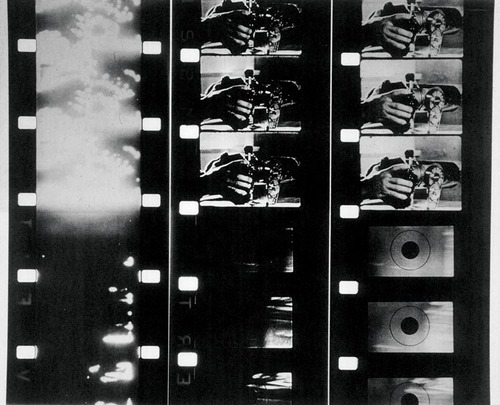
Erasure can be considered as a ‘surplus’ to the original “text”, in graffiti for example. Roland Barthes, writing in relation to Cy Twombly, who he describes as a “painter of writing”, wrote that “what constitutes graffiti is in fact neither the inscription nor its message but the wall, the background, the surface (the desktop); it is because the background exists fully as an object that has already lived, that such writing always comes as an enigmatic surplus… that is what disturbs the order of things; or again: it is insofar as the background is not clean that it is unsuitable to thought (contrary to the philosopher’s blank sheet of paper)…”. Galpin describes this with the word palimpsest, which originally referred to “writing material or manuscript on which the original writing has been effaced to make room for a second writing”.
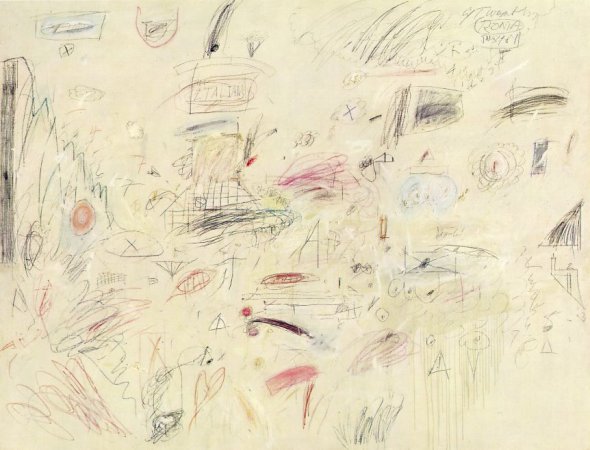
Rosalind Krauss wrote in reference to Twombly’s work : “the formal character of the graffito is that of a violation, the trespass onto a space that is not the graffitist’s own, the desecration of a field originally consecrated to another purpose, the effacement of that purpose through the act of dirtying, smearing, scarring, jabbing”. This could also be said of the films of Cathy Joritz, who uses various direct-on-film animation techniques to penetrate and appropiate the existing images on the celluloid (see Ghosting the Image and Drawn to Life programs), or this (less effective) video by Clare E. Rojas & Jeffrey Wright, titled ‘The Manipulators’ (1999), for which they used sharpie markers and white-out correctional fluid to cover and alter advertising and fashion magazine images.More fun stuff, based on the principle of animated graffiti: a great wall-painted animation by the BluBlu collective.
… which relates to this documentary, Matt McCormick‘s ‘The Subconscious Art of Graffiti Removal’ (2001), documenting and “analysing” (tongue-in-cheeck) the seemingly mundane job of graffiti removal (what graffiti writers call “buffing,” or “getting buffed”). Here’s a fragment:
And as Brian Dillon suggests, excess can be a form of erasure too. Dillon refers to Honoré de Balzac’s story ‘The Unknown Masterpiece’ (1837), in which the painter Frenhofer labours for years at a picture of a young woman, until she disappears, leaving only a tiny, perfect foot looming out of the surrounding chaos. An example of this idea can be found in Idris Khan‘s work. For ‘every…page of the Holy Koran’ (2004) (see image below), he made of photograph of every page of the Koran, which are overlaid to the point of illegibility. “The sacred text overwrites itself until it is a blur of meaningless ciphers, and the vertical gutter between the pages a deep black void”. He has subjected the same superimposition on books by works by Roland Barthes, Susan Sontag and Vilem Flusser, amongst others, and scores of Chopin and Beethoven. Chopin’s ‘Nocturnes for the Piano’ become a frenzied buzz of notes, while Beethoven’s ‘Sonatas’ appear as brooding blocks in which both the overlaid notation and the white spaces between the staves come to seem as meaningful as the dark constellation of notes. By giving the piece the title ‘Struggling to Hear . . . After Ludwig van Beethoven’s Sonatas’ (2005), Khan invokes the composer’s descent into deafness. Notes – laid graphically over one another – produce empty channels fringed by visual buzzing, a strange but compelling visual metaphor for Beethoven’s hearing loss. As David Crowley writes: “here, the technique of sous rature – based on the dynamics of presence and absence – resonates with human tragedy”.
More about Idris Khan and othere in next post.

